
20 minute read
Curriculum Initiative
Curriculum Initiative >> Will There Ever be a Perfect Math Program? By Lolita Mattos MS/HS Mathematics Teacher
Picture this…It’s the first day of school and the counselor’s office is flooded with students who are not satisfied with their class schedules. I give it no thought until I take attendance in my Intermediate Algebra class. There are only two students in my classroom, but my class list indicates that there should be twelve. I follow a hunch and go to Dr. G’s Pre-Calculus classroom, and what do I see? Exactly 75% of my students sitting comfortably in his Pre-Calculus classroom chatting away. I ask what they are doing there and they say that they should be in Dr. G’s Pre-Calculus class because they are in the 11th grade and this is what they “want” to take? (Of course it has nothing to do with wanting to be with their friends). I explain to them that they can only take the class if they have taken, and passed, the prerequisite classes. They all insist that they have taken the proper classes, but I know they haven’t. In order to make it official, I inform them that they must take, and pass, a “Readiness for Precalculus” test. Not surprisingly, only two out of ten students pass the test and are allowed to stay in Dr. G’s class. The rest, with great reluctance, accept the fact that they will be in my Intermediate Algebra class. I sigh and tell them “I get it! No one wants to be in the ‘dumb’ class, but trust me, it will all be worth it in the end.” They know that now. Properly placed students aren’t afraid to work in front of peers.
What is it with the pressure of having to have Pre-Calculus, AP Calculus, AP Stats, on your transcript? And why do students risk lowering their GPAs just to have the titles on their transcripts? Do they not know that excelling in other math classes is not a bad thing? Here at SIS, one of the mathematics department goals is to help dispel the myth that one must have AP Calculus on their transcript in order to increase their chances of being accepted into University. Does it look good? Absolutely! Is it imperative? No, it is not.
When it comes to reconfiguring a math program, one can’t help but imagine having a program that suits the needs and desires of all students, parents, and teachers. However, we all know that there is no “one size fits all” program for schools in general, particularly international schools. For many international schools, there are several reasons why it is difficult to achieve the perfect math program. For example, if the school is small, the ratio of teachers to subject choice is limited. This, in turn, also limits the variety and availability of AP or IB mathematics subjects. Also, because students are coming from schools all over the world that utilize programs other than AP or IB, having a “one size fits all” program can never work because it would be difficult to meet the needs of all students in any one particular class. Not being able to fulfill these needs has caused some schools to create specialized classes for students because he or she exceeds the level of expectations in mathematics. This has happened at SIS in the past, and while creating a specialized program sounded like a good idea at the time, it also set a dangerous precedent. After all, if you create a specialized class for one student, then how can you deny another? This was part of the reason that the mathematics department decided to re-evaluate the program at SIS for eventually, this will ultimately lead to teachers with too heavy workloads while trying to accommodate the needs of a handful.
Currently, there are two specialized classes that exist at SIS and while we all know that there are some students who are extremely high achievers and can afford to skip a grade, this is not the case for the vast majority. While both classes have extremely conscientious, independent students capable of achieving excellence, not everyone has the developmental capacity to fill in the gaps with concepts that they missed by skipping Prealgebra, on their own. While skipping Prealgebra had little to no effect on the first class, the second class is currently experiencing the ripple effect of not having all concepts mastered from Prealgebra which led to incompletion of a full-year Algebra 1 course. Although students in the second class are high achievers and have proven they can handle higher math, it is evident that they are lacking the concepts that are crucial in order to excel in Algebra 2. By creating these two “special” classes, it has caused some difficulty as to what we have to offer as a school. In the past, it was not unusual to have a class that consisted of three or less students. With the ripple effect in place, there were also whole classes comprised of students that were grossly underprepared.
While there is a lot of pressure for high school teachers to maintain high standards of excellence, the majority of educators are well aware that mathematics teachers receive the most pressure from parents more than any other subject. Therefore, by using their combined experiences, the SIS mathematics department began exploring ways to help all students achieve success and be prepared to take AP Calculus by their Senior year. A course for the 10th and 11th grades was created to fill in the gaps incurred in the middle and early high school years. The math department also developed a system that will cater to incoming students’ immediate needs, but at the same time, prepare them for higher level mathematics. In order to verify and confirm that SIS was on the right track, the team attended the 2017 Annual EARCOS conference in Kota Kinabalu. They attended a workshop titled “Tracking/Acceleration in MS Math: Pitfalls and Perils. This workshop also provided insights, and concrete strategies for improving our mathematics teaching and programs.
The preconceived notion that taking AP Calculus will guarantee admission to any University, will never go away, despite the reassurances and studies that prove otherwise. Parents are still going to push for it anyway. We are grateful to collaborate with EARCOS colleagues, as it confirmed that our mathematics curriculum is on the right track. Not every student dreams of taking the almighty AP Calculus class, but we can at least try and provide it for everyone who has a sincere desire to take it. Not because they are forced to, but because they want to. So, in answer to the question “will there ever be a perfect math program?” Of course not, but it will never stop us from trying!
Fall 2017 Issue 19
Curriculum Initiative >> The Importance of Trilingualism In The 21 st Century By Dr. John McGrath, Head of School, TCIS, john.mcgrath@tcis.ac.th
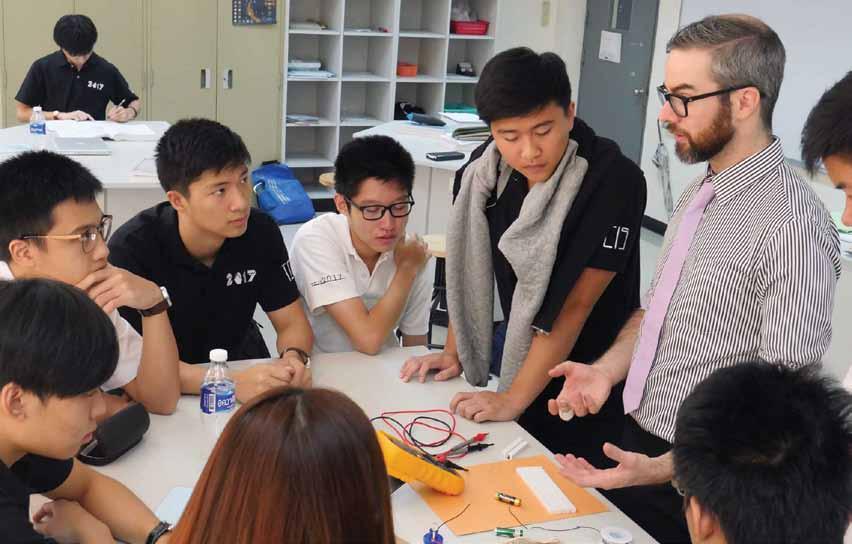
In today’s world, we often hear about the importance of focusing our educational efforts on STEM practices. While science and math are important, I feel that stressing them above all other forms of study misses an important point – that language and communication matter, now more than ever.
This is why I want to call for schools not to ignore STEM studies, but also to focus on a subject just as, if not more crucial – trilingualism. Trilingualism is the ability to speak three distinct languages. Science Daily writes about a research report that
“...brings forth six main areas where multilingualism and hence the mastery of complex processes of thought seem to put people in advantage. These include learning in general, complex thinking and creativity, mental flexibility, interpersonal and communication skills, and even a possible delay in the onset of age-related mental diminishment later in life.”
Let me put that into plain English for you. Knowing at least three languages helps you: • Learn other subjects – including STEM – better • Develop complex thought • Boost creativity • Become more mentally flexible • See arguments from more than one side • Communicate better • Relate more directly to other people • Delay Alzheimer’s and other mental diseases associated with aging
This alone should be enough to encourage trilingualism. But there is more to the story to be told. From an economic standpoint, trilingualism is crucial. As noted in The New York Times,
This means that as the world becomes more competitive, the more languages you speak, the better the chances you have of getting and holding a better job in the marketplace.
This makes sense when you think of the world we are creating. Not only are people becoming more mobile – and thus, willing to move for the right job – but the world is becoming smaller. Smart phones, tablets and other mobile devices make it just as easy to hire someone in Hong Kong as someone local to where you live. But they need to speak your language. The people who speak more languages will receive more, and higher paying, job offers. Those who are limited to their own language will have less ability to move and fewer chances to compete on the global stage. This is not the future – this is now.
Today English, Chinese and Spanish are the dominant languages in the world. That is a trend that is likely to grow in the future. The Chinese economy on its own is vast. But now that it is actively seeking out more international business opportunities, it will become perhaps the predominant economy in the world. Their business leaders will want to work with people who can speak their language. Therefore, learning Chinese is an essential skill for the future. The same
In fact, due to their size versus their growth potential, they may actually be more important than China for young people looking to seek a high return on the work they are willing and able to provide.
Finally, English. While the United States may be seen as losing influence in the world, the truth is they are an economic powerhouse. Political influence should not be seen in the same light as economic influence. They are and will remain a huge market and a huge supplier of jobs for the rest of this century. Add in Canada, the UK and Australia – another growing market – and it becomes clear that the English language is here to stay in terms of economic development, growth and the future. It should be self-evident that people who can speak all of the three dominant languages in the world will have a unique and potentially unstoppable advantage in the marketplace in the coming years.
Finally, let’s talk about computers and their influence. It seems obvious that communicating through computers will become increasingly more important as time goes on. This will force the industry – and all related companies – to default to common languages. Those will be English, Chinese and Spanish because of their numbers. What this means is that understanding all three languages will be of paramount importance – particularly for those involved in STEM learning. It makes no sense to have knowledge in math or science but not to be able to communicate it because the devices you need to spread it don’t speak what you do.
At my school, we have made trilingualism a priority. Students are taught three languages starting at a young age. This is important, because the younger you start learning a language, the more likely you are to become adept at it. I believe all schools should follow a similar path. Communication matters – and people are more comfortable talking to people who speak their language. This matters and it is important to our children’s future. In fact, I’d argue that given the cognitive benefits of trilingualism, it is even more important that STEM studies. Not everyone will be able to master science and math – but everyone can, if taught early, learn to become trilingual.
Learning multiple languages will give students a huge advantage no matter what else they choose to study. It will lead them to becoming more creative and that matters in all fields of the arts. It will help them in seeing how other people view things which is important to diplomacy, politics and generally being a good person. It will help them in being more flexible and that allows them to adapt to new situations with greater ease and assurance in their skills. And, it encourages communication skills that allow everyone from a STEM master to a middle manager to become more competitive.
All of this comes together to indicate just how important trilingualism is. It is the wave of the future, and we need to be able to be sure all of our students can ride it.
LEADING WHERE IT MATTERS MOST
THE INTERNATIONAL SCHOOL LEADERSHIP PROGRAM FROM USF AND WSU

Do you want to transform school culture and make a lasting impact on education in society? Do you wish to participate in a critical thinking, problem-solving approach to leadership indiverse environments? Join a unique two-year program designed specifically for EARCOS members!
UNIQUE FEATURES • Combines online coursework and on-site classes (held during EARCOS conferences) • Program internship prepares participants for a Washington State Principal Certificate that meets certification requirements in many other states • Instructors are university faculty and international school leaders • Teamwork and collaborative learning
APPLY FOR SPRING OR FALL education.wsu.edu/certification/international
FOR MORE INFORMATION University of San Francisco Dr. Walter Gmelch whgmelch@usfca.edu usfca.edu Washington State University Dr. Shannon M. Calderone shannon.calderone@wsu.edu education.wsu.edu | wsu.edu
Curriculum Initiative >> Successful Start for All: A unique de- sign to intentionally build strong partnerships between home and school in the early years
By Evelyn Chaveriat, Director of Admissions and Drew Gerdes, Elementary School Assistant Principal Concordia International School Shanghai
Successful start New Concordia families comfortably gather for story time in Concordia’s Welcome Center.
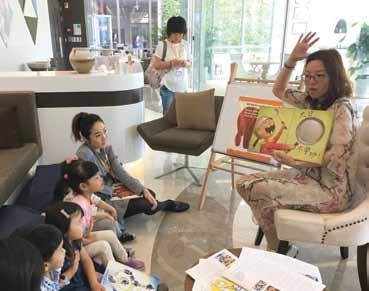
Starting school for the first time can be an overwhelming experience for young children. However, the youngest learners at Concordia International School Shanghai began the 2017-18 school year with a safe, low-stress transition to the classroom thanks to our Successful Start program. The program, a collaboration between the elementary school and admissions office, is designed to ease young students into their new environment by allowing them to visit classrooms and meet teachers and classmates in a way that relieves anxiety and fosters social learning that benefits children, families, and teachers.
Because social-emotional intelligence is so important for young children, they need time to establish trust with caregivers and develop social competence with their peers. During the first three days of school, small groups of six preschool-3 students take part in 90-minute classroom periods, where they can engage with the teacher and classmates at a pace that is developmentally appropriate. The following week, students attend three half-day sessions with their entire class before starting their regular full-day sessions which they will continue for the rest of the school year.
These “mini-school day” events, complete with playtime, story and snack time, and a ride on the school bus, are meant to acclimate incoming families to the campus and help lessen the stress of attending school for the first time. Incoming students are also invited to join current students and parents at the elementary school spring carnival and track/field fun day. New Concordia parents are excited to see their children embracing the school experience, and, by attending these events alongside their children, they have an opportunity to connect with current members of the school community.
Young parents, or parents of young children, often have unique questions and seek guidance or reassurance from the school. Successful Start provides an opportunity for teachers and administrators to address questions from new Concordia parents and mitigate their concerns. While students explore their new classrooms with their teachers and classmates, parents attend information sessions on ways they can partner with the Concordia to cultivate a positive school experience for their children. These sessions also share strategies that parents can use at home to help their children gain confidence and strong self-regulatory skills.
Helping young students feel comfortable and confident in their new surroundings benefits early childhood teachers as well. By lessening the anxiety of new students and slowly integrating them into the new school environment, teachers are able to focus on keeping their classrooms running smoothly. At the same time, teachers are fostering deeper relationships with parents, allowing for earlier and stronger parent-teacher partnerships.
While there is no way to alleviate all the tears and worries associated with attending school for the first time, programs like Concordia’s Successful Start certainly make it easier for children, parents and teachers to start the school year off right.

Successful Start_Parents join their students in the classroom for fun activities.
TAUGHT IN CARACAS. READY FOR THE WORLD.

2017
See where ISS can take you. Discover new opportunities at our upcoming International Recruitment Conferences and Job Fairs.
October 14 • iFair ®
November 18 • iFair ®
December 3-5 •Atlanta, GA GRAND HYATT BUCKHEAD
2018
January 5-8 • Bangkok, Thailand SHANGRI LA
February 8-11 • New York, NY MARRIOTT MARQUIS TIMES SQUARE
Visit ISS.edu
Curriculum Initiative >> STEAM is Strong at Taipei American School By Ramy Youssif, Lower School Art Taipei American School
Three years ago the K-5 art program at Taipei American School (TAS) started incorporating grade level classroom integrated projects, teaching the design process, and developing STEAM curriculum to enhance the already strong art content and material skills teachers were providing in art classes. The overlapping of ideas inspired new, exciting projects, and also helped develop a budding visiting artist program while continuing to focus on meaningful, creative, and material exposure filled experiences for students in the Lower School.
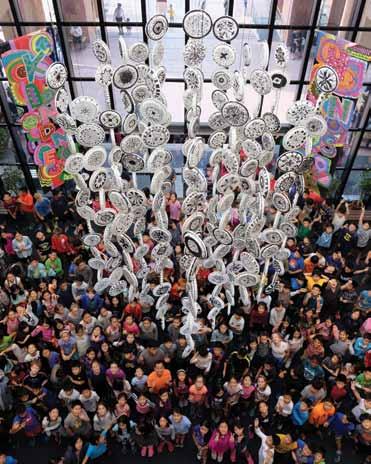
Changes started to be noticed immediately after administration suggested to integrate where overlapping ideas fit well, and when communication was shared that the Lower School would be implementing STEAM curriculum the following year. Around the same time, a new mode for creativity in the form of a 3D printer was donated, along with a group of parents who volunteered their time to create an artwork in the halls of the school, which straightaway inspired art teachers to implement new ideas in preparation for the future.
In October of 2014 digital displays of fifth grade Alien Architecture designs and display cases of their 3D printed designs emerged in the hallways, and were being mistaken for middle school artworks! Shortly after, Lower School administration, who have been beyond supportive of the art program, provided an opportunity to develop an art project with some eager, artistic parents. The art team took the opportunity as a chance to start talking about the design process with students and turned a third grade clay project into a huge group mosaic project. The remainder of the year continued to show variety of design process guided projects.
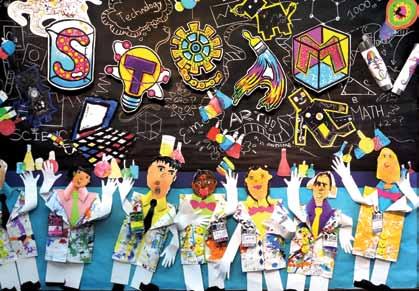
STEAM drawing installation and circle painting banners created by grades k-5 students with visiting artist Mr. Hiep Nguyen.
Formosa Forever, the whole grade level, parent group, and art department collaboration was unveiled the following year, and will forever be a part of the Lower School building. Heather Hanson inspired full body, kinetic drawings that integrated math and science concepts into students’ colorful chalk artworks on a rooftop of the school. The application, Motion Portrait, brought Van Gogh styled self-portraits to life, while a wind energy unit constructed more durable pinwheels while also teaching color mixing and the six-step color wheel. Insect anatomy content has been incorporated into drawing projects to reinforce even more science content. Technology continued to fuel a lot of project ideas, and digitally designed and individually stylized 3D printed glasses were being worn by art students! All of this and more lead to last year’s annually theme based exhibition that was dedicated to STEAM.
Another successful fall exhibition displayed at least two STEAM projects per grade level that was highlighted by robotic animal circuit drawings with working lights, and fourth graders’ exposure to the TAS Upper School’s visiting ceramic 3D printing artist, Yao Van Den Heerik. Afterwards, with special thanks to EARCOS funding, the Lower School hosted their first overseas visiting artist, Hiep Nguyen. Hiep brought his Circle Painting and STEAM drawing projects to all three divisions in TAS, and a weekend workshop exposed approximately twenty teachers from various international schools in the region. His processes and collaboration with the Lower School art team resulted in a large mural painting and an enormous K-5 hanging installation in the main lobby of TAS.
Integration, the design process, and STEAM continues to be a strong, yet still growing force in the TAS Lower School art program, and with all of the recent experiences there is much excitement to see what amazing, inspirational art will come next.
Curriculum Initiative >> Project Innovate a New Vision for Future-Ready Learning at Canadian Int’l School Hong Kong By Ms. Aly Trezis, alisontrezise@cdnis.edu.hk
Canadian International School of Hong Kong (CDNIS) has enjoyed a reputation for innovation since it was founded in 1991. As an IB through-train school, with results ranking among the best in the world, CDNIS enjoys a privileged position on the world stage for progressive educational practices, attracting exceptional international educators. Recognised as one of the first Apple Distinguished Schools in Asia, CDNIS introduced the first personal 1:1 laptop programme in Hong Kong over 10 years ago and has since remained at the cutting edge of digital innovation. This combined with a thriving Maker Culture, dynamic visual and performing arts, including an inspirational Artist in Residence Programme, and a genuine commitment to student-led sustainability projects has demonstrated the school’s commitment to creativity and innovation.
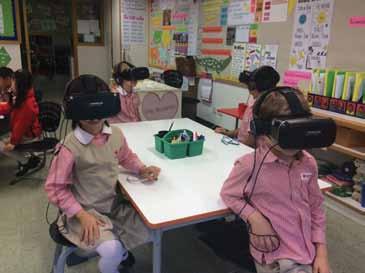
A good example of this is the new Lower School one-to-one robotics programme, extending their making and coding skills and developing their creativity and critical thinking beyond what can be achieved in a brief programme of weekly lessons. A new addition on campus is the Science & Innovation Lab whereby students can experiment with making, creating and responding to real world based projects.
In the Upper School, a student led initiative, The Blueprint Club, supports this next-level thinking by providing an incubator for developing innovative ideas, encouraging students to push boundaries and reach beyond themselves, while solving real world problems. One group is currently working with Arduino hardware and software to monitor the use of recycling bins at the school with a view to increasing recycling.
Project Innovate is embedded into mainstream learning, quite different to the add-on programmes being offered elsewhere. Teachers are provided with professional development opportunities, such as design-thinking workshops, to build upon their skills and understandings, but are also challenged to find new ways to empower and engage students in their classrooms. Encouraging staff to bring their own passions into school, to share and develop networks, co-create projects with others and continue to push the boundaries is a key aspect of Project Innovate’s philosophy.
Students experience alternative realities in the classroom.
CDNIS has now developed a new, holistic vision for innovative education, to provide students with the skills, dispositions and mindsets they need to be successful in the fast-changing world. Project Innovate, grew from a think tank approach, driven by the desire to build upon the innovative culture flourishing in the school. Its core purpose, to deliver future-ready learning, is built around the World Economic Forum’s framework of 21st Century Skills, which bring together foundational skills, with the 21st century competencies of collaboration, communication, critical thinking and creativity and the character qualities of resilience, initiative, curiosity, adaptability, empathy and leadership. This involves an increased emphasis upon handson, experiential learning and authentic problem solving, in combination with the inquiry-based trans and inter-disciplinary approaches embedded in the IB philosophy. Students are encouraged to ask questions and follow their interests in contexts closely related to the real world, while teachers challenge them to take their learning to the next level, thinking always about what comes next.











